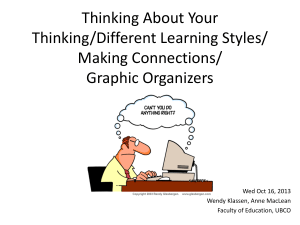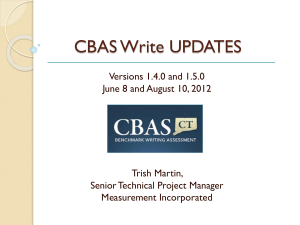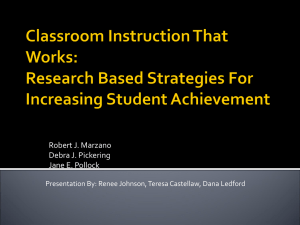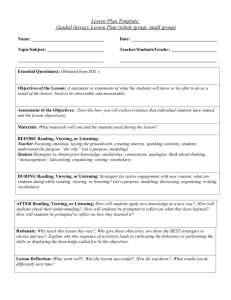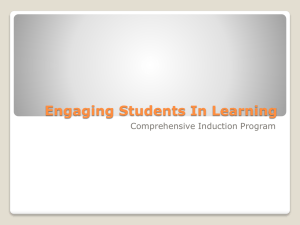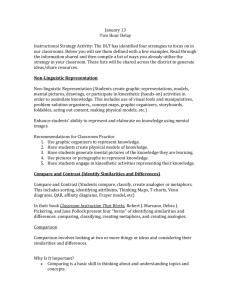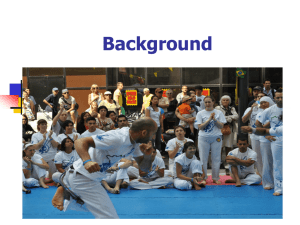Bethany Walker Module 9 Teaching Strategy Essay
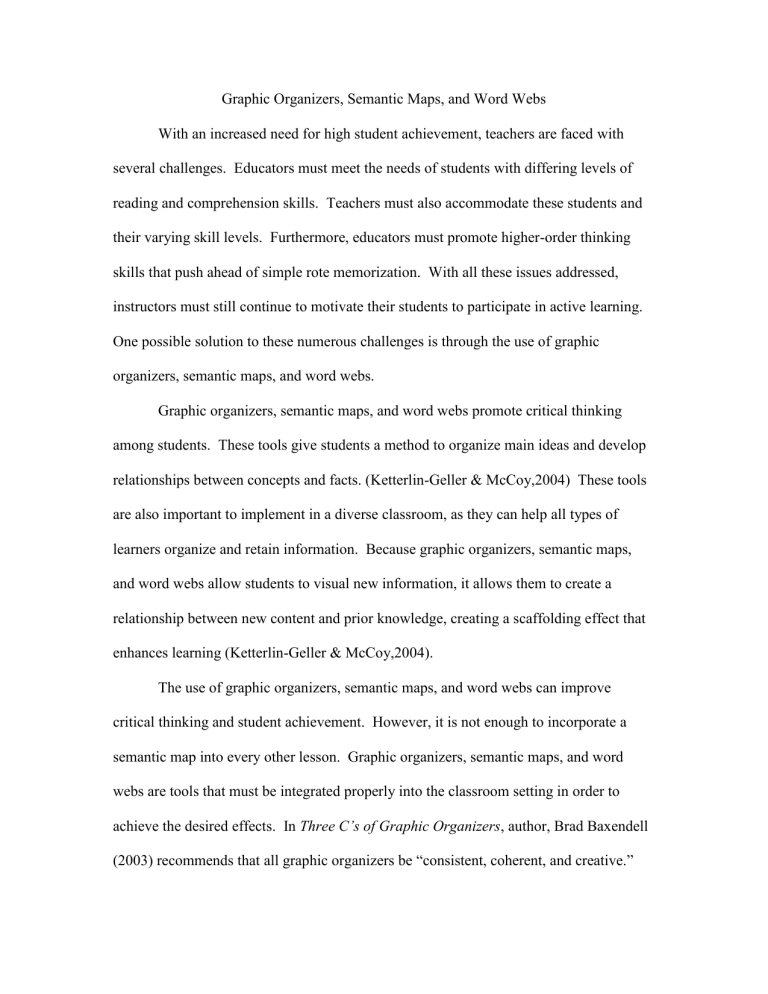
Graphic Organizers, Semantic Maps, and Word Webs
With an increased need for high student achievement, teachers are faced with several challenges. Educators must meet the needs of students with differing levels of reading and comprehension skills. Teachers must also accommodate these students and their varying skill levels. Furthermore, educators must promote higher-order thinking skills that push ahead of simple rote memorization. With all these issues addressed, instructors must still continue to motivate their students to participate in active learning.
One possible solution to these numerous challenges is through the use of graphic organizers, semantic maps, and word webs.
Graphic organizers, semantic maps, and word webs promote critical thinking among students. These tools give students a method to organize main ideas and develop relationships between concepts and facts. (Ketterlin-Geller & McCoy,2004) These tools are also important to implement in a diverse classroom, as they can help all types of learners organize and retain information. Because graphic organizers, semantic maps, and word webs allow students to visual new information, it allows them to create a relationship between new content and prior knowledge, creating a scaffolding effect that enhances learning (Ketterlin-Geller & McCoy,2004).
The use of graphic organizers, semantic maps, and word webs can improve critical thinking and student achievement. However, it is not enough to incorporate a semantic map into every other lesson. Graphic organizers, semantic maps, and word webs are tools that must be integrated properly into the classroom setting in order to achieve the desired effects. In Three C’s of Graphic Organizers , author, Brad Baxendell
(2003) recommends that all graphic organizers be “consistent, coherent, and creative.”
Walker 2
Below are several strategies for the effective use of graphic organizers suggested by
Baxendell (p.47):
Consistent o Create a standard set of graphic organizers o Establish a routine for implementing them in the classroom
Coherent o Provide clear labels for the relationships between concepts o Limit the number of main ideas covered o Minimize distractions
Creative o Use during all stages of the lesson design o Incorporate during homework or test review o Add illustrations o Implement with cooperative groups and pairs
One excellent graphic organizer to utilize in the classroom is the Skyscraper. The
Skyscraper is based on Bloom’s Taxonomy and allows the student to think about the way they think. To use this organizer, the instructor must explain to the students that the topic they are covering is like climbing a skyscraper. Knowledge, or the facts, are easy to locate and thus are on the first floor. But as you begin to ascend the skyscraper, it becomes more and more challenging. The next floor, the student achieves comprehension and continues to the third floor – application. The student then moves on to analysis, synthesis, and evaluation. Not only does this method encourage critical thinking, but it also allows to students evaluate how they achieve deeper understanding of concepts. An example of the Skyscraper organizer from Hooked on Thinking (Kroll,
2004, p.676) is shown below.
Walker 3
Graphic organizers, semantic maps, and word webs have extensive uses in the
ICT classroom. While commonly used for vocabulary retention, many of these tools can be used for concepts as well. For example, an instructor could create a master word web using the parts of a computer to address Unit 2, Compentecy 1 of the ICT I curriculum.
The term computers could then be divided into input devices and output devices. The students must then list as many parts of the computer as possible. This activity would not
Walker 4 only allow students to become more familiar with computers terms, but help them gain a deeper understanding of computer functions.
Graphic organizers, semantic maps, and word webs can have an enormous impact on student achievement. Research has shown that students taught with these tools, regardless of reading or achievement level, develop higher level thinking skills than students that did not receive such instruction (Ketterlin-Geller & McCoy,2004).
However, it is important to remember that these instructional strategies be carefully planned to optimize student success.
Walker 5
References
Baxendell, B.W. (2003). Consistent, coherent, creative the three c’s of graphic organizers. Teaching Exceptional Children , 35(3), 46-53. Retrieved June 21,
2009, from Academic Search Premier database.
Ketterlin-Geller, L.R. & McCoy, J.D. (2004). Rethinking instructional delivery for diverse student populations: serving all learners with concept-based instruction.
Intervention in School & Clinic , 40(2), 88-95. Retrieved June 21, 2009, from
Academic Search Premier database.
Kroll, M. & Paziotopoulos, A. (2004). Hooked on thinking. Reading Teacher , 57(7), 672-
677. Retrieved June 21, 2009, from Academic Search Premier database.
Online: http://www.eduplace.com/graphicorganizer/ . Contains several blank master templates of graphic organizers.
Online: http://olc.spsd.sk.ca/DE/PD/instr/strats/graphicorganizers/index.html
. Contains strategies for implementing graphic organizers and links to other helpful websites.



